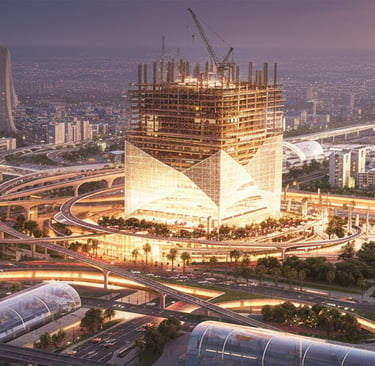The Future of Construction and Engineering in Saudi Arabia: Vision 2030 and Beyond
Explore how Vision 2030 is transforming Saudi Arabia’s construction and engineering sector with innovation, sustainability, and mega-projects.
CONSTRUCTION INDUSTRY OF SAUDI ARABIA
Mohammad Awad Contracting Est.
9/30/20252 min read


Saudi Arabia is undergoing one of the most ambitious transformations in the world. With Vision 2030 as the driving force, the Kingdom is reshaping its economy, infrastructure, and society. At the heart of this transformation is the construction and engineering sector, which plays a critical role in delivering the mega-projects that will define the future of the nation.
From futuristic smart cities to cutting-edge industrial hubs, the opportunities for innovation and collaboration in Saudi Arabia are vast. But what does the future look like for the industry? Let’s explore.
Vision 2030 and Its Impact on Construction
Vision 2030 is more than a roadmap — it’s a national strategy that demands world-class infrastructure and modern engineering solutions. The government is investing billions in:
Mega-projects such as NEOM, Qiddiya, The Red Sea Project, and Diriyah Gate.
Expanding transportation networks, including airports, railways, and seaports.
Building smart cities designed for sustainability and digital innovation.
These initiatives are opening doors for both local and international firms to contribute expertise in design, fabrication, and construction management.
The Rise of Sustainable Engineering
As global attention shifts toward sustainability, Saudi Arabia is integrating green building practices and renewable energy solutions into its projects. Engineers and contractors are now focusing on:
Energy-efficient building systems.
Smart water management.
Sustainable materials and eco-friendly fabrication methods.
This shift is not only reshaping construction practices but also ensuring that the Kingdom’s rapid development aligns with global sustainability standards.
Technology Driving Transformation
Innovation is at the center of Saudi Arabia’s engineering growth. Key technologies include:
Building Information Modeling (BIM): Revolutionizing project planning and execution.
Artificial Intelligence & Automation: Improving productivity and reducing costs.
Modular Construction & Prefabrication: Speeding up delivery while maintaining high quality.
Smart Infrastructure: Integrating IoT systems for efficiency and safety.
These advancements are transforming traditional construction into a digitally connected ecosystem.
Opportunities for Contractors and Engineers
The Kingdom’s development plans create opportunities in multiple sectors:
Residential & Commercial: Meeting the growing demand for modern housing and commercial hubs.
Industrial Projects: Expanding manufacturing, logistics, and energy facilities.
Tourism & Entertainment: Developing luxury resorts, stadiums, and cultural centers.
Public Infrastructure: Roads, bridges, and urban planning to support population growth.
Local companies, especially in steel fabrication and construction, are strategically positioned to play a vital role in these projects by providing specialized expertise and scalable solutions.
Challenges to Overcome
Despite the vast opportunities, the industry faces challenges:
Shortage of skilled labor and reliance on international expertise.
Need for adaptation of global engineering standards to local conditions.
Balancing speed of delivery with quality and safety requirements.
Companies that can address these challenges through training, partnerships, and innovation will be the ones that thrive in the new era.
Looking Beyond 2030
Saudi Arabia’s transformation is only beginning. By 2030, the country aims to diversify its economy and reduce dependence on oil. The construction and engineering industry will remain at the forefront, delivering projects that not only build infrastructure but also shape communities and lifestyles.
At AMA Contracting, we are proud to contribute to Saudi Arabia’s transformation by supporting projects across different sectors — from large-scale developments like Qiddiya and Diriyah, to national infrastructure with Saudi Electricity Company, and even retail spaces such as popular coffee shop chains. These experiences give us a unique perspective on the future of construction and engineering in the Kingdom, and the responsibility that comes with it.
For firms working in steel fabrication, architecture, and engineering, the future promises a landscape full of opportunities — where innovation, collaboration, and sustainability define success.
Key Takeaway:
The future of construction and engineering in Saudi Arabia is about more than buildings and structures. It’s about nation-building, creating sustainable cities, and enabling economic growth. Vision 2030 is setting the stage — and the industry must rise to meet it.


